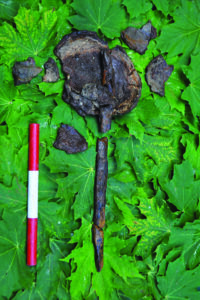 Archaeologists excavating a Stone Age lake bed in Motala, Sweden, have unearthed two skull impaled on spikes. The skulls were discovered with the stakes still firmly embedded inside them, reaching from the base of the skull to the top of the cranium.
Archaeologists excavating a Stone Age lake bed in Motala, Sweden, have unearthed two skull impaled on spikes. The skulls were discovered with the stakes still firmly embedded inside them, reaching from the base of the skull to the top of the cranium.
Other remains were also found at the site, among them skull fragments from 11 people of varying ages and animal bones. Radiocarbon dating confirms that all of the bones are the same age: 8,000 years old. That makes these heads on spikes the oldest ones found in the world, and by a lot.
The lake bed, a shallow lake during the Neolithic, was used as a ceremonial burial ground during the Mesolithic era.
Archaeologists are exploring two theories to explain why the human skulls were mounted on wooden stakes before being placed in the lake bed
“One thought is that it was part of some sort of secondary burial ritual where the skulls were removed from dead bodies that had initially been placed elsewhere,” said Hallberg.
“After the soft tissue had rotted away, the skulls were removed and placed on the stakes before being placed in the shallow lake.”
Another theory is that the mounted skulls are trophies brought back from battles with other settlers in the area.
“It may have been a way to prove one’s success on the battlefield,” Hallberg explained.
DNA and isotope analysis might help fill in some of the blanks, like if everyone in buried on the site was related or if they were raised in the area or came from elsewhere. If they’re all part of the same family, it seems unlikely that the impaled skulls were battle trophies.
This excavation site has been a regular source of unique discoveries over the past two years. It gained immediate notoriety last summer when a Stone Age antler bone dildo was discovered by the same team that found the spiked skulls. Then last October the team discovered a treasure trove of artifacts — parts of a bow, a paddle, an axe handle and blade — all made out 9000-year-old wood. The bow was the first of its kind ever found in Sweden. That’s the miracle of sodden earth and peat in action again, keeping perishable materials from perishing.